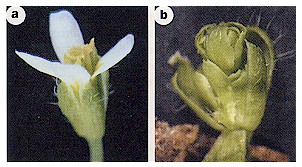LINKS
Gene Sequence
 The
sep triple mutant is strikingly similar to double mutants lacking the B (AP3/PI)
and C (AG) organ identity genes. Taken together, the SEP
gene products are required for the activity of the B and C genes.
The
sep triple mutant is strikingly similar to double mutants lacking the B (AP3/PI)
and C (AG) organ identity genes. Taken together, the SEP
gene products are required for the activity of the B and C genes.
Wild-type flowers (left) have of four whorls of organs consisting of sepals, petals, stamens and carpels. The sep1 sep2 sep3 triple mutant (right) produces flowers that consist of a seemingly endless reiteration of sepals